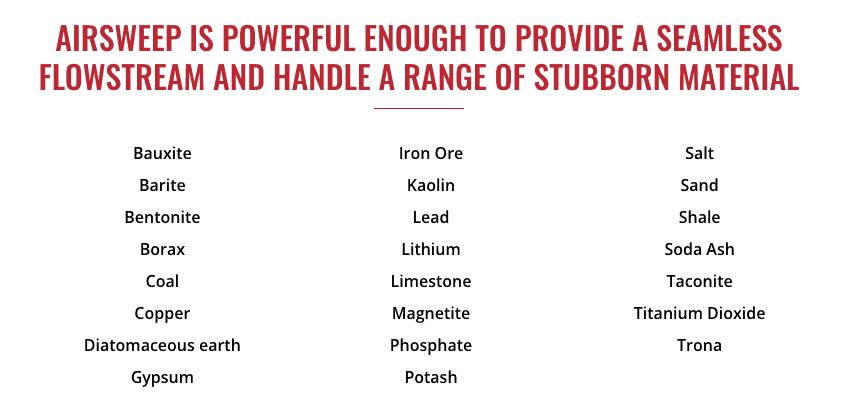
Mined materials are used in almost all industries, from construction to consumer goods. However, these materials can be challenging to move and process because of their physical and chemical properties.
Let’s take a closer look at the common problems that can occur while processing mined materials, and how we can help.
Types of Mined Materials
Mined materials range from metallic ores like iron and copper to non-metallic minerals such as potash and gypsum. The World Mining Data names five different categories:
- Iron and Ferro-Alloy Metals: Iron, Chromium, Cobalt, Manganese, Molybdenum, Nickel, Niobium, Tantalum, Titanium, Tungsten, Vanadium
- Non-Ferrous Metals: Aluminium, Antimony, Arsenic, Bauxite, Beryllium, Bismuth, Cadmium, Copper, Gallium, Germanium, Indium, Lead, Lithium, Mercury, Rare Earth Minerals, Rhenium, Selenium, Tellurium, Tin, Zinc
- Precious Metals: Gold, Platinum-Group Metals (Palladium, Platinum, Rhodium), Silver
- Industrial Minerals: Asbestos, Baryte, Bentonite, Boron Minerals, Diamond (Gem/Industrial), Diatomite, Feldspar, Fluorspar, Graphite, Gypsum and Anhydrite, Kaolin (China-Clay), Magnesite, Perlite, Phosphate Rock (incl. Guano), Potash, Salt, Sulfur, Talc (incl. Steatite and Pyrophyllite), Vermiculite, Zircon
- Mineral Fuels: Steam Coal (including Anthracite and Sub-Bituminous Coal), Coking Coal, Lignite, Natural Gas, Petroleum (incl. Natural Gas Liquids), Oil Sands, Oil Shales, Uranium
Each of these has unique flow characteristics that present distinct challenges. For instance, metallic ores often possess high density, while non-metallic minerals may be prone to moisture retention.
Challenges in Material Flow
Material flow problems can lead to machine downtime and increased maintenance costs, which decreases profitability. The most common flow issues encountered while handling mined materials are:
- Bridging. The material forms an arch above the outlet of a hopper or silo. This slows or even completely stops the flow, causing production delays.
- Ratholing. The material accumulates along the vessel walls, forming a channel that restricts the flow. “Old” trapped material also remains in the vessel, instead of first in/first out flow.
- Segregation. The materials segregate based on size or density during flow, resulting in inconsistent quality and potential waste of valuable resources.
Dangers of overflow
While material blocks slow or stop the flow, there’s also a danger of overflow–when equipment breaks down, causing tons of material to suddenly spill to the ground.
The material spill can injure workers, release potentially flammable powders into the air, and take days to clean up.
A processing facility may have to completely shut down operations until a material spill is cleared. Workers will also have to manually clear the material, which can pose health and safety risks.
That’s why mining industry regulations require mines and mined materials facilities to have safety devices and protocols in case any equipment malfunctions.
Ensure safe and efficient flow of mined materials
Control Concepts, Inc. provides a complete solution for material flow problems. Our two superstar products, AirSweep and DAZIC, can work together for smooth and safe operations.
AirSweep is a material flow aid that guarantees on-demand, first-in/first out flow. It is used in the mining industry to resolve bridging, ratholing, and segregation–and save a lot of time and money in the process!
AirSweep’s patented nozzle delivers quick bursts of compressed air or gas along the container walls, breaking down bridges and ratholes without damaging the container or the material. It can activate even heavy, wet, or sticky mined materials. (Read more about AirSweep in the mined material industry.)

DAZIC zero speed switches prevent material spills. It monitors the operational speed of rotating, reciprocating, or conveying equipment. It then triggers an alarm or shuts down a system if the equipment is operating at an unsafe or inefficient speed.
DAZIC can be installed on any equipment that has a rotating part, including conveyor belts, bucket elevators, motors, and more. It is inexpensive, durable, and reliable–and used by both global manufacturing firms and small, local businesses.
For many of those companies, DAZIC is an important part of plant efficiency and safety compliance. (Read more about how a zero speed switch helps you meet safety regulations.)
Success stories
AirSweep and DAZIC have helped mined materials facilities prevent the toughest material flow problems.
- A mineral processing plant took an hour to fill one supersack with mined materials. AirSweep reduced filling time to just two minutes, for a 1200% increase in productivity.
- One of the fastest growing mining companies in Africa were concerned about the safety issues and high energy consumption of air cannons – especially since workers still spent up to two hours a day clearing leftover material blocks. AirSweep completely solved the problem, prompting them to say, “You should be on billboards everywhere!”
- A global tire manufacturer that uses carbon black installed DAZIC zero speed switches to meet safety standards. A carbon black spill could cause flash fires and breathing problems, and complicated cleaning processes since the material doesn’t dissolve in water and solvents.
- A ready-mix concrete plant loads up to 250 tons of gravel an hour into its feeders. “It would be a nightmare if the DAZIC didn’t shut the conveyor belt down. I don’t even want to think about it,” said the plant supervisor. They installed DAZIC zero speed switches nearly 20 years ago–and they are still working! “They have never quit.”
Take charge of the material flow of mined materials
With AirSweep and DAZIC, you’re not just investing in a product – you’re investing in smoother operations, consistent product quality, and ultimately, a more robust bottom line. Contact us to find out more about how to improve material flow in your facility.





Comments are closed